Mary Howitt
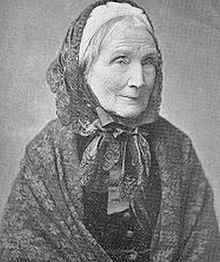 Mary Howitt | |
| Born |
12 March 1799[1] Coleford, in Gloucestershire |
|---|---|
| Died |
30 January 1888 (age 89) Rome |
| Education | at home |
| Occupation | Writer |
| Spouse(s) | William Howitt |
| Children | yes |
| Parent(s) | Samuel Botham and Anne (née Wood) |
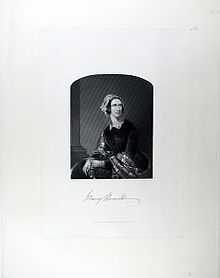
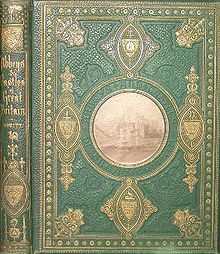
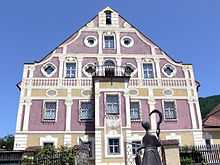
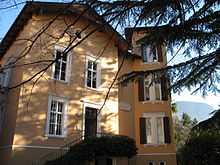
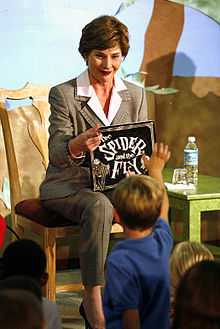
Mary Howitt (12 March 1799 – 30 January 1888) was an English poet, and author of the famous poem The Spider and the Fly. She was born Mary Botham at Coleford, in Gloucestershire, the temporary residence of her parents, while her father, Samuel Botham, a prosperous Quaker of Uttoxeter, Staffordshire, was looking after some mining property. Samuel had married his wife Ann in South Wales in 1796 when he was 38 and she was 32. They had four children Anna, Mary, Emma and Charles. Their Queen Anne house is now known as Howitt Place.[3]
Mary Botham was educated at home, and read widely; she commenced writing verses at a very early age.[1] Together with her husband she wrote over 180 books.[4]
Marriage
On 16 April 1821 she was married in to William Howitt, and began a career of joint authorship with her husband. They lived initially in Heanor in Derbyshire where William was a pharmacist.[3] It was not until 1823, when they were living in Nottingham, that William decided to give up his business with his brother Richard and concentrate with Mary on writing.[3] Their literary productions at first consisted chiefly of poetical and other contributions to annuals and periodicals, of which a selection was published in 1827 under the title of The Desolation of Eyam and other Poems.
William and Mary mixed with many of the important literary figures of the day including Charles Dickens, Elizabeth Gaskell and Elizabeth Barrett Browning. In 1837 they went on a tour of the north and stayed with William and Dorothy Wordsworth.[3] Their work was well regarded, as can be seen from the minister George Byng's present in 1839 from Queen Victoria. She gave him a copy of Mary's book Hymns and Fireside Verses.[3] In the same year, her brother-in-law Godfrey Howitt set out with his wife and her family to emigrate to Australia, arriving at Port Phillip in April 1840.[5] The life of Mary Howitt was completely bound up with that of her husband; she was separated only from him during the period of his Australian journey (1851–54). On removing to Esher in 1837 she commenced writing her well-known tales for children, a long series of books which met with signal success.[1] They moved to London in 1843, and following a second move in 1844 they counted Tennyson amongst their neighbours.[3]
Scandinavia
While residing at Heidelberg in 1840, her attention was directed to Scandinavian literature, and in company with her friend Madame Schoultz, she set herself to learn Swedish and Danish. She afterward translated and introduced Fredrika Bremer's novels (1842–1863, 18 vols) to English readers. Howitt also translated many of Hans Christian Andersen's tales, such as[1]
- Only a Fiddler (1845)
- The Improvisators (1845, 1847) 1900 edition on Internet Archive
- Wonderful Stories for Children (1846)
- The True Story of every Life (1847).[1]
Among her original works were The Heir of West Way Ian (1847). She edited for three years the Drawing-room Scrap Book, writing (among other articles included) "Biographical Sketches of the Queens of England". She edited the Pictorial Calendar of the Seasons, translated Ennemoser's History of Magic, and took the chief share in The Literature and Romance of Northern Europe (1852). She also produced a Popular History of the United States (2 vols. 1859), and a three-volume novel called The Cost of Caergwyn (1864).[1]
In June 1852, the three male members of the family, accompanied by Edward La Trobe Bateman, sailed for Australia in the hope of finding a fortune. William would be reunited with his brother Godfrey Howitt, while Mary and her two daughters, the elder, Anna Mary Howitt, who had just returned from a year in Munich with Kaulbach (this adventure was later published as a book) moved into the Hermitage, Mr Bateman's cottage in Highgate. This had previously been occupied by Dante Gabriel Rossetti.[6] However, they returned a number of years later. William wrote several books describing the flora and fauna of Australia.[3] Her son, Alfred William Howitt, was to be renowned as an Australian explorer, anthropologist and naturalist and the discoverer of the remains of the explorers Burke and Wills, which he brought to Melbourne for burial.
Other children included: Herbert Charlton Howitt, who was drowned while engineering a road in New Zealand; Anna Mary Howitt, wife of Alfred Alaric Watts, the biographer of her father and author of An Art-Student in Munich, who died on a visit to her mother in Tirol in 1884;[7] and Margaret Howitt, the writer of the Life of Fredrika Bremer and of the memoir of her own mother.[8]
Mary Howitt's name was attached as author, translator or editor to upwards of 110 works. She received a silver medal from the Literary Academy of Stockholm, and on 21 April 1879 was awarded a civil list pension of £100. a year. In her declining years she joined the Roman Catholic Church, and was one of an English deputation received by Pope Leo XIII on 10 January 1888. Her Reminiscences of my Later Life were printed in Good Words in 1886. The Times says, speaking of the Howitts:
Their friends used jokingly to call them William and Mary, and to maintain that they had been crowned together like their royal prototypes. Nothing that either of them wrote will live, but they were so industrious, so disinterested, so amiable, so devoted to the work of spreading good and innocent literature, that their names ought not to disappear unmourned.
Mary Howitt was away from her residence in Meran in Tyrol spending the winter in Rome when she died of bronchitis on 30 January 1888.[1]
Her works
Among the works written, like those already mentioned, independently of her husband, were:
- ' Sketches of Natural History (1834)
- ' Wood Leighton, or a Year in the Country (1836)
- ' Birds and Flowers and other Country Things (1838)
- ' Hymns and Fireside Verses (1839)
- ' Hope on, Hope ever, a Tale (1840)
- ' Strive and Thrive (1840)
- ' Sowing and Reaping, or What will come of it (1841)
- ' Work and Wages, or Life in Service (1842)
- ' Which is the Wiser? or People Abroad (1842)
- ' Little Coin, Much Care (1842)
- ' No Sense like Common Sense (1843)
- ' Love and Money (1843)
- ' My Uncle the Clockmaker (1844)
- ' The Two Apprentices (1844)
- ' My own Story, or the Autobiography of a Child (1845)
- ' Fireside Verses (1845)
- ' Ballads and other Poems (1847)
- ' The Children's Year (1847)
- ' The Childhood of Mary Leeson (1848)
- ' Our Cousins in Ohio (1849)
- ' The Heir of Wast-Waylan (1851)
- ' The Dial of Love (1853)
- ' Birds and Flowers and other Country Things (1855)
- ' The Picture Book for the Young (1855)
- ' M. Howitt's Illustrated Library for the Young (1856; two series)
- ' Lillieslea, or Lost and Found (1861)
- ' Little Arthur's Letters to his Sister Mary (1861)
- ' The Poet's Children (1863)
- ' The Story of Little Cristal (1863)
- ' Mr. Rudd's Grandchildren (1864)
- ' Tales in Prose for Young People (1864)
- ' M. Howitt's Sketches of Natural History (1864)
- ' Tales in Verse for Young People (1865)
- ' Our Four-footed Friends (1867)
- ' John Oriel's Start in Life (1868)
- ' Pictures from Nature (1869)
- ' Vignettes of American History (1869)
- ' A Pleasant Life (1871)
- ' Birds and their Nests (1872)
- ' Natural History Stories (1875)
- ' Tales for all Seasons (1881)
- ' Tales of English Life, including Middleton and the Middletons (1881)[1]
The Spider and the Fly
Mary Howitt's poem the "Spider and the Fly" was originally published in 1829. When Lewis Carroll was readying Alice's Adventures Under Ground for publication, he replaced a parody he had made of a negro minstrel song[9] with a parody of Mary's poem. The Lobster Quadrille, which is an important part of Alice's Adventures in Wonderland, is a parody of Mary's poem concerning a spider and a fly.[10]
The poem was a Caldecott Honor Book in October 2003.[11]
References
- ↑ 1.0 1.1 1.2 1.3 1.4 1.5 1.6 1.7 Dictionary of National Biography, 1885–1900, Volume 28, Mary Howitt
- ↑ A book for sale for $1,750 accessed 2 October 2007
- ↑ 3.0 3.1 3.2 3.3 3.4 3.5 3.6 Mary Howitt site accessed 3 October 2007
- ↑ William Howitts entry in the Australian Dictionary of Biography accessed 4 October 2007
- ↑ Godfrey Howitt in Aust. Dict. of biography accessed 3 October 2007
- ↑ Little Memoirs of the Nineteenth Century accessed 3 October 2007
- ↑ Anna Mary Howitt's ODNB entry: Retrieved 9 July 2011. Subscription required.
- ↑ William Howitt in the Dictionary of National Biography
- ↑ Gardner, Martin., The Annotated Alice, 1998
- ↑ Lewis Carroll's parody of Mary's poem accessed 3 October 2007
- ↑ Childrens Book awards announced. New York Times 6 October 2007 accessed 8 October 2007
| Wikimedia Commons has media related to Mary Howitt. |
| Wikiquote has quotations related to: Mary Howitt |
| Wikisource has original works written by or about: Mary Howitt |
Further reading
- Mary Howitt: an Autobiography, edited by her daughter, Margaret Howitt (1889)
- C. R. Woodring, Victorian Samplers – William & Mary Howitt (1952)
- A. Lee, Laurels and Rosemary – The Life of William & Mary Howitt (1955)
External links
- Works by Mary Botham Howitt at Project Gutenberg
- Works by or about Mary Howitt at Internet Archive
- Works by Mary Howitt at LibriVox (public domain audiobooks)

- Complete list of her works
- Archival material relating to Mary Howitt listed at the UK National Archives
- Papers of Mary and William Howitt are held at Manuscripts and Special Collections, The University of Nottingham
|